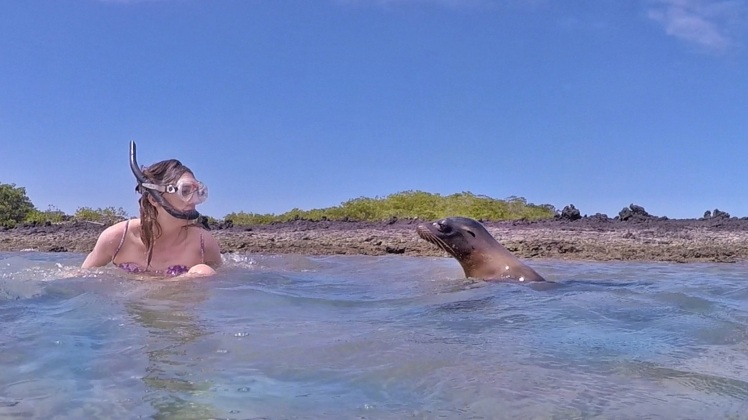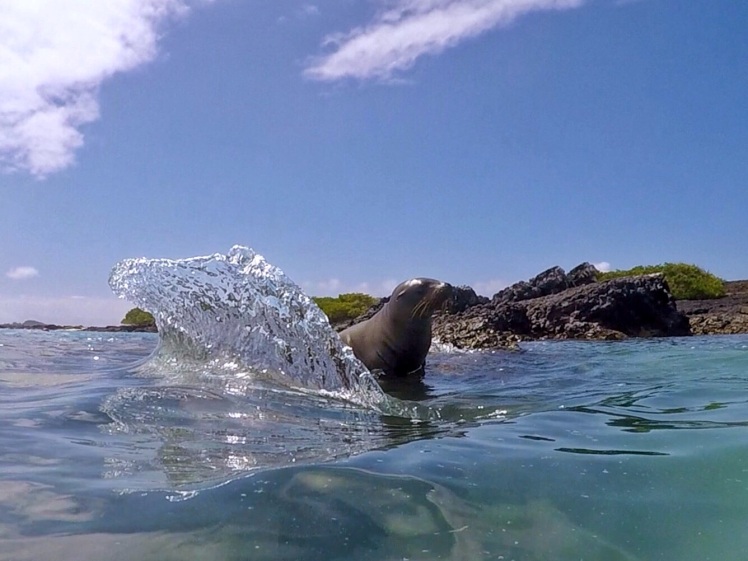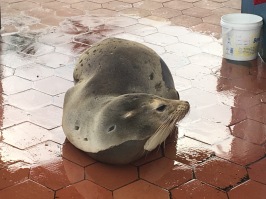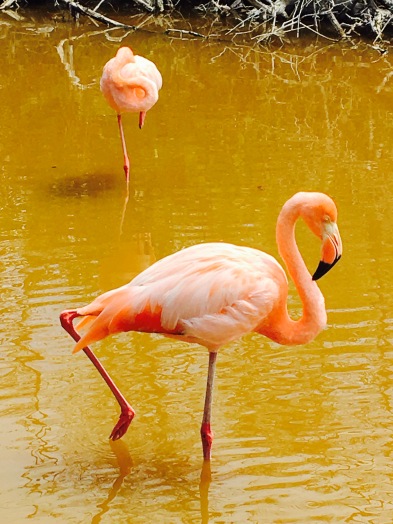The Galapagos are no doubt a dream destination. Somewhere in everyone’s imagination is an image of the islands; a strange world where giant tortoises are as common as sheep in New Zealand, penguins live miles from their Antarctic homelands, sea lions laze around amongst the strutting blue footed boobies. Add sharks, turtles, swimming iguanas, pelicans, flamingoes – and loads of other animals unique to the islands – all roaming freely without a care for the gawping humans, and you start to get a picture of the island menagerie we had in mind. It’d be fair to assume we were setting ourselves up for disappointment. Nope, the Galapagos were all that. And more.




In spite of this, we still hadn’t decided on the Galapagos when we left the UK 10 months earlier. Not because it wasn’t well and truly on the bucket list, but because its reputation for crazy good wildlife comes with a reputation for crazy high prices. This is mainly because the most common way to see the islands is by cruise. A supposedly rock-bottom, last minute discount for $800 per person for a 4 night cruise sealed the deal: We were going DIY. We made a hit list of must-see animals, and worked out that we should be able to see them all for just $350 per person ($120 of which went on the national park entry before we’d even left the airport) for 5 nights.
The Hit List:
Sea Lions
Flamingoes
Pelicans
Giant Tortoises
Penguins
Marine Iguanas
Blue Footed Boobies
Sally Lightfoot Crabs
The sight when we landed wasn’t at all what we’d expected. The Galapagos we’d pictured was essentially an evolutionist’s Eden. The view from the plane window looked more like landing on Mars – a scorched black wasteland scattered with lava rocks, dry grey grasses and the odd cactus. The airport on Baltra Island was previously used as a US army base in case they needed to protect the Panama Canal. Now, it’s the main gateway for tourists visiting the islands.
Our DIY approach immediately helped us decide where to stay, as only three islands are inhabited; Santa Cruz, San Cristobal and Isabela. A five minute boat shuttle took us from Baltra to the ‘main island’ of Santa Cruz. Our plan was to spend two days exploring the reserves and beaches here, before taking a three hour speed boat ride ($25) to spend two days on Isabela – a wilder and less inhabited island about 100km west. We left ourselves a spare day, and some spare dollar, for a boat tour to go a little further afield for anything on our list still missing at the end.
Santa Cruz’s main town, Puerto Ayora, is where most visitors either stay or begin their cruise. While the small town has schools, volleyball pitches, and a supermarket, it’s still very much the animals’ home turf. Walk along the seafront, and you’re sharing the pavement with marine iguanas. Take a seat on a park bench, and you could find yourself sharing it with a friendly sea lion. Drive out of town and you’ll have to watch out for giant tortoises ambling across the road.
We’d found ourselves some giant tortoises before we even arrived in Puerto Ayora. El Chato reserve ($2 entry) is between the airport and the town, so the perfect way to start exploring. The tortoises were everywhere, happily wallowing in mud puddles or munching away on fallen guayava fruits. They didn’t seem to mind sharing the grasslands with humans, but let you know if you got too close with some spooky Darth Vader breathing as they swiftly pulled their heads inside their shells.
We split the rest of our time on Santa Cruz between the town, Tortuga Bay and Garropatero. Tortuga Bay is a 45 minute walk out of town. The sand was easily the whitest sand we’ve ever seen, even on a completely overcast day, but it’s hard to pay attention to the sand when the rocks are crawling with giant orange and blue Sally Lightfoot crabs, a heron casually stalks along the shallow waters, and a procession of marine iguanas are making their way up the beach. Oh, and the finches. You can’t move for finches. The dozens of different types, from Tool Using to Blood Sucking, helped inspire Darwin’s work on evolution. The waters at both Playa Tortuga and Garropatero are supposedly good spots to see Pacific green turtles and white tipped reef sharks, but when we were there the visibility was barely good enough to see our hands in front of our faces.
Puerto Ayora’s fish market is the perfect example of how the animals are part of everyday human life in the Galapagos. Pelicans hop hopefully along the fish counter, sea lions roll into position below to catch any scraps, frigate birds peer down from their perches, and the ubiquitous finches, lizards and iguanas watch from the sidelines.
We had a knock on our door one evening and were invited to help eat the huge piles of freshly barbecued fish, picked up at the market by the hostel owner, topped with squeezes of fresh orange juice, and shared with the rest of her family.
Over on Isabela our first stop was Concha de Perla, a lagoon surrounded by mangroves close to the ferry dock. It’s known for being a good place to spot eagle rays, turtles and penguins, but the water visibility and incredibly strong currents meant we spent more time lounging in the sun on the wooden platform with sea lions and crabs, watching poor marine iguanas be swept into overhanging branches by the currents.
Laguna Salinas, a short walk from where the main road in town meets the beach, easily blew Garropatero’s lone flamingo out of the water (not literally – not even the Galapagos does torpedo flamingoes). The lake is home to dozens of flamingoes, and the boardwalk around the edge of the lake leads to a Tortoise Breeding Centre (free entry) that’s home to tiny new hatchlings, teenage tortoises and giant adults.
We’d got pretty far through our animal hit list with our DIY approach, but penguins were still missing. We couldn’t leave without seeing the most northerly wild penguins in the world, so from Isabela we booked the Las Tintoreras morning tour ($45pp with Sea Lion Tours). It was our ideal tour; no faffing about with included meal breaks or tenuous side trips, just a direct line to the penguins. Ten minutes away from the dock and we were immediately greeted by the topsy-turvy sight of two penguins hopping between cacti along volcanic lava rocks. Seconds later a turtle swam by! We carried on to see white tipped sharks swimming in channel between lava rocks with one brave turtle paddling amongst them.



The highlight of the tour, and probably of our whole time in the Galapagos, was snorkelling with penguins and sea lions. Sea lions are nicknamed the labradors of the sea, which is pretty accurate. They’re not at all afraid of humans, they were playfully swimming circles around us, headbutting the GoPro and instigating staring competitions when they popped their heads above water.
Our lasting memories of the Galapagos are a wildlife whirlwind: truly unforgettable. Sure, we missed out on close-ups of the unique blue-footed boobies, and we didn’t dive with hammerhead sharks or manta rays, but now we know it’s possible to make this dream destination a reality without bankruptcy, we have a good reason to come back.




































Brought back fab memories, thanks guys! And well done on doing it on such a budget. Love continuing to experience Central and now South America through your blogs. Cheers, Rob, Kat and kids x
LikeLike
Thanks Callanders! We’ve actually read it back ourselves once or twice already because it was so unreal. R&Tx
LikeLike